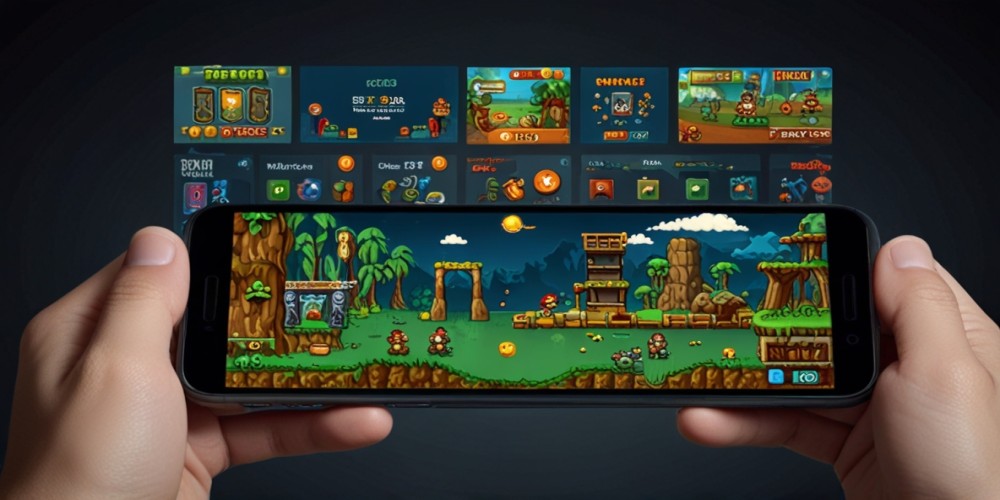Evolution of Mobile Gaming: From Snake to Cloud-Based Blockbusters
Jul-09-2024

Mobile gaming has undergone incredible transformations, and what an adventure it's been! If you rewind the clock to the late '90s, the mobile gaming scene was all about simplicity and pixelated screens. Remember Snake? That addictive game where you guided a slithering line of pixels around your tiny Nokia screen? Back then, it was the bee's knees, the kind of game that made you forget the world outside your phone. Fast forward a couple of decades, and mobile games have transformed into full-blown cinematic experiences that you can carry in your pocket. We're talking about blockbuster titles, cloud-based gaming, and experiences so immersive, they make you forget you're holding a phone. Let's dive into this fascinating evolution and see how we went from guiding a snake to battling it out in cloud-powered arenas.
Snake: The Birth of Mobile Gaming
It all started with Snake. Released on the Nokia 6110 in 1997, this simple yet endlessly entertaining game was a game-changer—literally. Snake was basic, but that was its charm. You controlled a line that grew longer with every dot it ate, and your goal was to avoid crashing into yourself. It was straightforward, easy to play, and, more importantly, accessible to just about everyone. You didn’t need to be a hardcore gamer to enjoy Snake. It was a game that brought people together, much like a friendly neighborhood barbecue.
Snake laid the groundwork for mobile gaming by proving that phones could be more than just communication devices—they could also entertain. It laid the groundwork for the events that were yet to unfold, and boy, did the future hold some surprises.
The Java and Symbian Era: Stepping Stones to Complexity
After Snake, mobile games began to evolve. The early 2000s saw the rise of Java and Symbian-based games, which were more complex and graphically advanced than their predecessors. Games like Space Impact and Bounce started to pop up, offering players more depth, better visuals, and, importantly, a way to pass the hours during lengthy commutes or tedious meetings.
While these games may seem basic compared to modern offerings, they marked a noteworthy advancement from the era of Snake. They were like the training wheels of the mobile gaming industry, helping developers learn how to make more engaging, immersive experiences while working within the limitations of early mobile technology.
The Smartphone Revolution: Touchscreens and App Stores
And then came the smartphones. The debut of the iPhone in 2007, followed closely by the introduction of the App Store in 2008, revolutionized the entire landscape. Suddenly, mobile gaming was no longer confined to simple, pre-installed games. Developers could now create and distribute games with unprecedented ease, and players had access to a treasure trove of titles at their fingertips.
Games like Angry Birds and Doodle Jump became instant hits, captivating millions of players worldwide. These games were fun, addictive, and perfectly suited to the new touchscreen interface. Swiping, tapping, and tilting became the new way to play, and mobile gaming began to grow exponentially.
With the rise of the App Store, mobile games started to reach a broader audience. Casual gamers, who might never have touched a console or PC game, were now picking up their phones and playing during lunch breaks, on the bus, or while waiting in line at the grocery store. Mobile gaming had officially gone mainstream.
Freemium and the Rise of In-App Purchases
As mobile gaming grew, so did its business model. The introduction of the freemium model—where games can be downloaded at no cost but feature optional in-app purchases—transformed the gaming landscape. Titles such as Candy Crush Saga and Clash of Clans have generated billions in revenue by offering players the option to buy extra lives, special items, or cosmetic upgrades.
This model allowed developers to reach a massive audience by removing the barrier to entry, while still monetizing their games in a big way. It was a win-win situation for both players and developers, and it paved the way for some of the biggest successes in mobile gaming history.
However, the freemium model wasn't without its critics. Some players felt that it encouraged pay-to-win mechanics, where those willing to spend money had a significant advantage over those who didn’t. Despite the controversy, there's no denying that freemium games dominated the mobile gaming landscape throughout the 2010s.
The Graphics Leap: From 2D to 3D and Beyond
As mobile devices became more powerful, so did the games. The early days of 2D, pixelated graphics gave way to stunning 3D environments that could rival console and PC games. Titles like Infinity Blade and Real Racing showcased what mobile devices were capable of, with graphics that were once unimaginable on a phone.
The evolution of mobile graphics was nothing short of a marvel. Developers were squeezing every bit of power out of these tiny devices, creating games that looked and felt amazing. Players were no longer just tapping on a screen; they were exploring richly detailed worlds, driving high-speed cars, and battling fierce enemies in fully realized 3D environments.
These advancements in graphics brought mobile gaming to a new level, attracting a more hardcore audience that had previously dismissed mobile games as casual, lightweight experiences. Now, mobile gaming was serious business, and it was only going to get bigger.
The Cloud-Based Revolution: Gaming Without Boundaries
Today, we're witnessing the next big leap in mobile gaming: cloud-based gaming. This innovative technology enables gamers to directly stream games onto their devices, removing the necessity for high-performance hardware. Games like Fortnite, PUBG Mobile, and Genshin Impact are merely scratching the surface, delivering experiences that rival console gaming quality on a device that fits in your pocket.
Cloud gaming is a game-changer in every sense of the word. It allows players to access massive, visually demanding games without concerns about storage capacity or hardware constraints. All you need is a good internet connection, and you're good to go.
This shift to the cloud is breaking down barriers and making gaming more accessible than ever before. Whether you're on a high-end smartphone or a budget device, cloud gaming ensures that everyone can enjoy the same high-quality experience. It's a testament to how far we've come, from the humble days of Snake to the blockbuster titles of today.
The Future: What’s Next for Mobile Gaming?
As we gaze ahead, the potential of mobile gaming seems boundless. With advancements in augmented reality (AR), virtual reality (VR), and 5G technology, we're on the brink of a transformative age of mobile gaming is on the horizon, where the boundaries separating the physical realm from the virtual experience will become increasingly indistinct. Imagine playing a game where the world around you is the battlefield, where you can engage with characters and objects as though they were physically present before you.
Moreover, as mobile devices grow increasingly advanced in their capabilities, we can look forward to an increasing number of breathtaking games that truly challenge the limits of creativity and technology. Developers are always looking for new ways to innovate, and the future of mobile gaming is sure to be filled with surprises that will keep us all hooked.
Conclusion: From Snake to the Cloud, It's Been One Wild Ride
Mobile gaming has evolved in ways that few could have predicted. What started as a simple game of Snake on a black-and-white screen has evolved into an international sensation that links countless gamers from around the globe. From the early days of Java games to the rise of the App Store and the freemium model, and now to the era of cloud gaming, mobile gaming has continually pushed the envelope.
The journey of mobile gaming is a story of innovation, accessibility, and a little bit of magic. It's a testament to how far technology has come and how much it can impact our lives, one game at a time. So, the next moment you grab your phone to dive into a game, take a moment to appreciate the incredible journey that brought us here—from the humble beginnings of Snake to the cloud-based blockbusters that define mobile gaming today.







